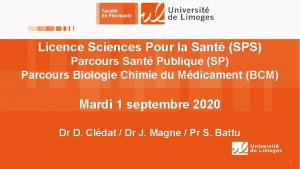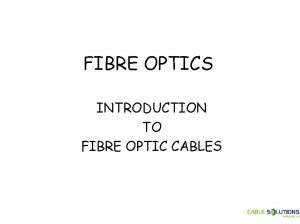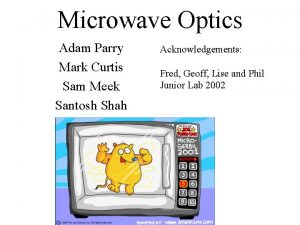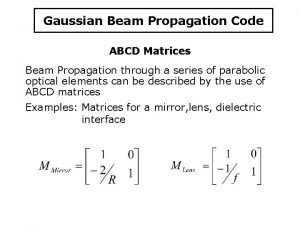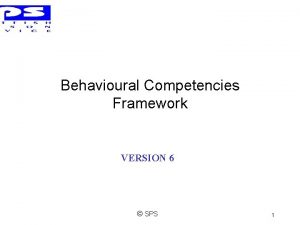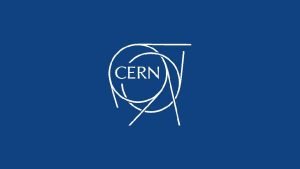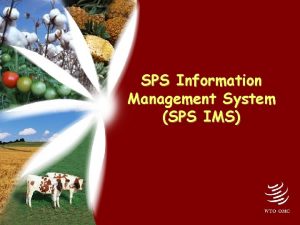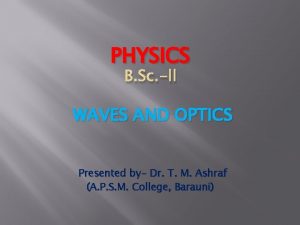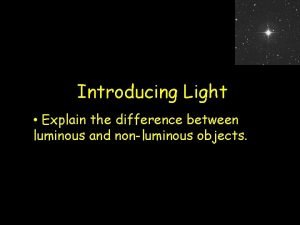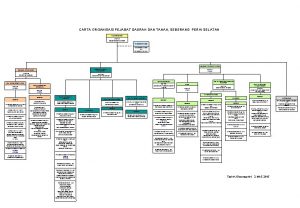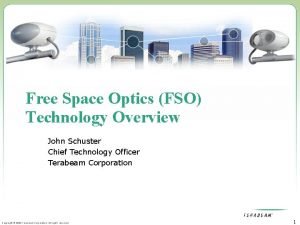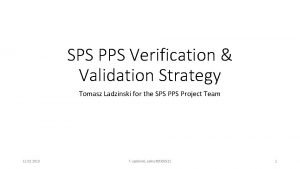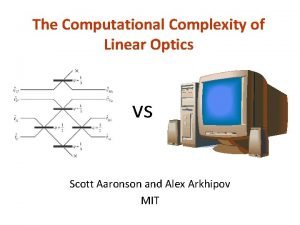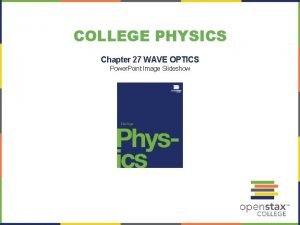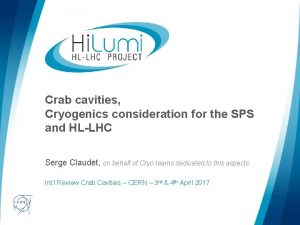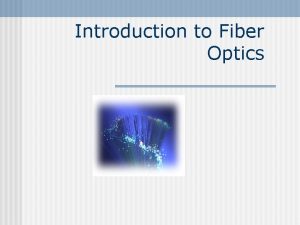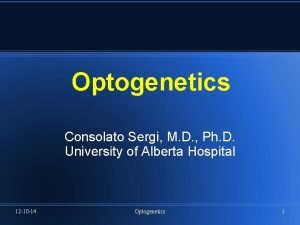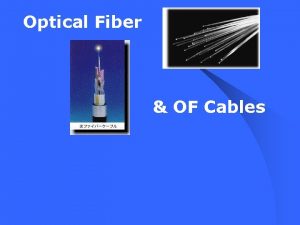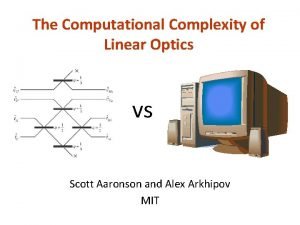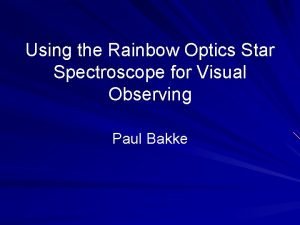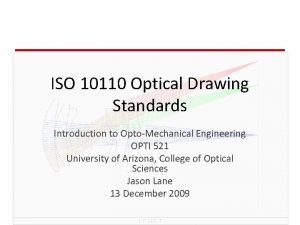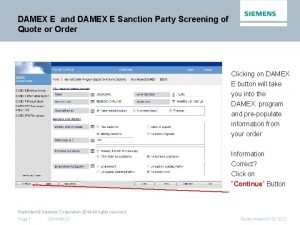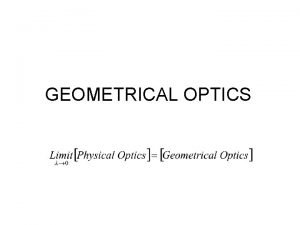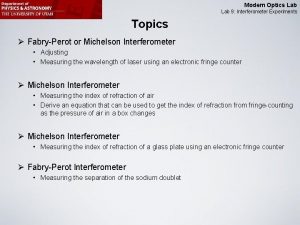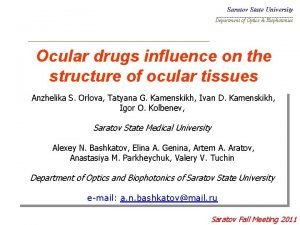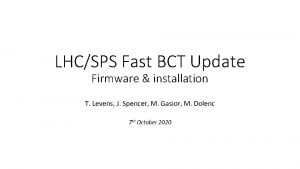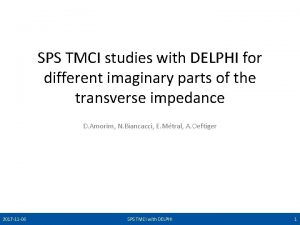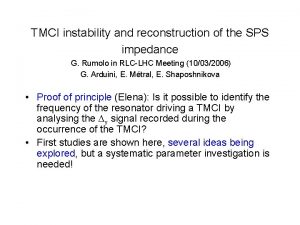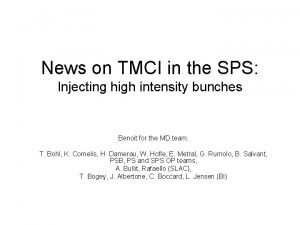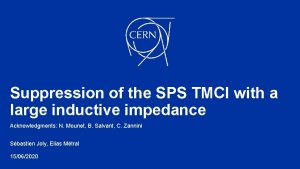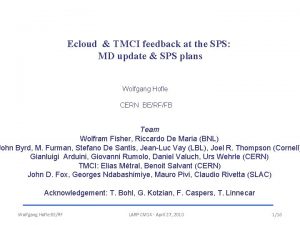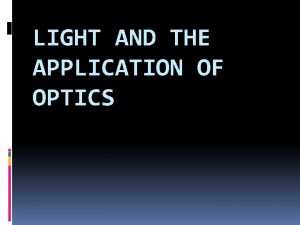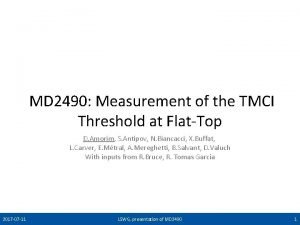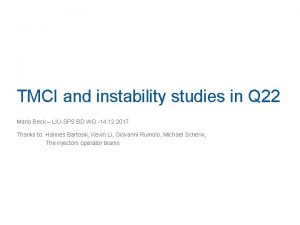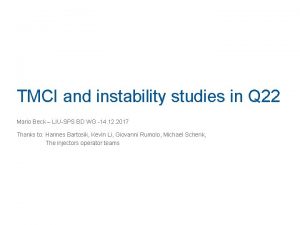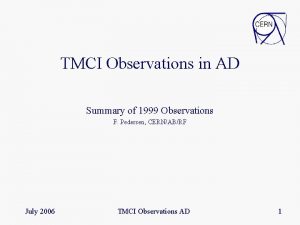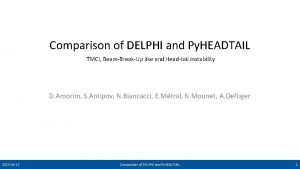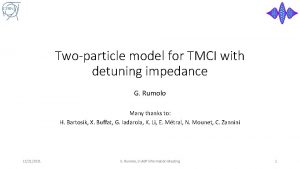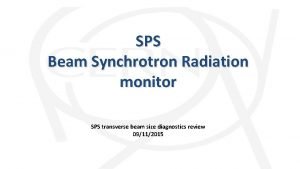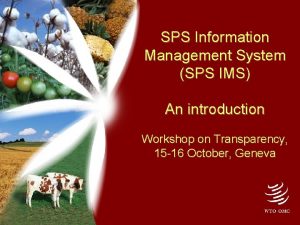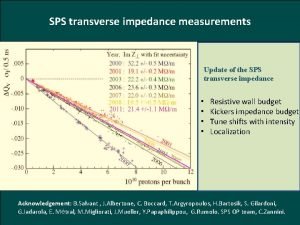SPS TMCI with the Q 22 optics Kevin


































- Slides: 34

SPS TMCI with the Q 22 optics Kevin Li, H. Bartosik, M. Beck, E. Bjorsvik, M. Carla, G. Kotzian, T. Levens, M. Schenk HSC Section Meeting – 27. 11. 2017

Outline Context: The vicious transverse mode coupling instability is one of the fundamental intensity limitations in the SPS. In the pre-Q 20 era, this limit was set at around 1. 4 e 11 ppb – way below the required 2. 6 e 11 specified for LIU. With the Q 20 optics the threshold was raised to about 4. 5 e 11 ppb. An intermediate optics – Q 22 – was considered as alternative as it is less demanding in terms of RF power during certain parts of the cycle. Outline: • Measurement overview • Identifying the TMCI threshold • Voltage scans • Mitigation of the TMCI 26. 11. 2017 Kevin Li - HSC Section Meeting

Preamble • SPS TMCI has a long history of studies… • It can be reasonably well reproduced using a broadband resonator impedance model at around 1. 3 GHz B. Salvant 26. 11. 2017 Kevin Li - HSC Section Meeting H. Bartosik

Preamble • SPS TMCI has a long history of studies… • Strong coupling takes place between mode -2 and -3 short bunch 26. 11. 2017 Kevin Li - HSC Section Meeting long bunch

Preamble • SPS TMCI has a long history of studies… • Mitigation methods… 26. 11. 2017 Kevin Li - HSC Section Meeting

Preamble • SPS TMCI has a long history of studies… • It can be reasonably well reproduced using a broadband resonator impedance model at around 1. 3 GHz Q 22 – M. Beck 26. 11. 2017 Kevin Li - HSC Section Meeting

MD overview Machine setup: QPH = -0. 05 => Q’ = 1. 6 QPV = -0. 3 => Q’ = 0. 7 RF 200 = 2. 70 k. V RF 800 = 0. 27 k. V Beam Setup: PSB: MD 4: PS : MD 7: SPS: LHC 2: 26. 11. 2017 MD_LHCINDIV_HI_INT_SPS_IMPEDANCE_PS MD_26_L 7200_Q 22_2017_V 1 Kevin Li - HSC Section Meeting

MD overview 26. 11. 2017 Kevin Li - HSC Section Meeting

MD overview • Injection from the PS into the SPS – monitoring of the extracted vs. the injected intensity 26. 11. 2017 Kevin Li - HSC Section Meeting

MD overview 26. 11. 2017 Voltage scan Kevin Li - HSC Section Meeting Intensity scan at reduced long. emittance Chromaticity scan Intensity scan Wire scans • Injection from the PS into the SPS – monitoring of the extracted vs. the injected intensity

MD overview • Injection from the PS into the SPS – monitoring of the extracted vs. the injected intensity • We will look at the intensity scan in order to identify the TMCI threshold at a voltage of 2. 7 MV and a long. emittance of around 0. 3 e. Vs 26. 11. 2017 Intensity scan Voltage scan Kevin Li - HSC Section Meeting

Intensity scan • Scanning the injected intensity into the SPS we notice a sudden decrease of the transmission at around 23: 10 26. 11. 2017 Kevin Li - HSC Section Meeting

Intensity scan • Scanning the injected intensity into the SPS we notice a sudden decrease of the transmission at around 23: 10 26. 11. 2017 Kevin Li - HSC Section Meeting

Intensity scan • Scanning the injected intensity into the SPS we notice a sudden decrease of the transmission at around 23: 10 • Plotting it slightly differently – where is the TMCI threshold… : D? 26. 11. 2017 Kevin Li - HSC Section Meeting

Intensity scan • After identifying the TMCI threshold via the intensity scan, we did a voltage scan at a fixed injected intensity, at around 4 e 11 ppb. 26. 11. 2017 Kevin Li - HSC Section Meeting

Intensity scan • After identifying the TMCI threshold via the intensity scan, we did a voltage scan at a fixed injected intensity, at around 4 e 11 ppb. • Increasing the voltage did not show any clear improvement… still to be understood. • At lower intensity, a dependence on the RF voltage is seen. 26. 11. 2017 Kevin Li - HSC Section Meeting

TMCI threshold • The TMCI threshold in the SPS for Q 22 at a voltage of 2. 7 MV and a long. Emittance around 0. 3 e. Vs is at 2. 4 e 11 ppb! • LIU requires an injected intensity of 2. 6 e 11 ppb. • Does this mean Q 22 is excluded as potential alternative for LIU? 26. 11. 2017 Kevin Li - HSC Section Meeting

TMCI threshold • The TMCI threshold in the SPS for Q 22 at a voltage of 2. 7 MV and a long. Emittance around 0. 3 e. Vs is at 2. 4 e 11 ppb! • LIU requires an injected intensity of 2. 6 e 11 ppb. • Does this mean Q 22 is excluded as potential alternative for LIU? 26. 11. 2017 Yet another wall? ! Kevin Li - HSC Section Meeting

TMCI threshold • The TMCI threshold in the SPS for Q 22 at a voltage of 2. 7 MV and a long. Emittance around 0. 3 e. Vs is at 2. 4 e 11 ppb! • LIU requires an injected intensity of 2. 6 e 11 ppb. • Does this mean Q 22 is excluded as potential alternative for LIU? Perha ps no t! 26. 11. 2017 Yet another wall? ! Kevin Li - HSC Section Meeting

Wideband feedback system components Pickup Equalization Closed orbit rejection Digital signal processing system J. Fox et al. • Complete processing channel from pickups through kicker, running a digital reconfigurable system up to 4 GS/s is installed and ready for use at 3. 2 Gs/s. Now includes multi-bunch processing of up to 64 bunches in any configuration. • Actuators: o 2 stripline kickers o 2 x 2 power amplifiers with 250 W, frequency range: 5 – 1000 MHz o Augmented by a slotline kicker in 2018 26. 11. 2017 Kevin Li - HSC Section Meeting Predistortion Power amplifiers Wideband kickers

Wideband feedback system components Pickup Equalization Closed orbit rejection Digital signal processing system Predistortion Power amplifiers Wideband kickers J. Fox et al. • Complete processing channel from pickups through kicker, This system has been demonstrated to be effective against TMCI in the slow risetimes running a digital reconfigurable system upatodemonstrator 4 regime. As system, it runs at limited power with, hence, reduced GS/s is installed and ready for use at 3. 2 Gs/s. Now includes capabilities. We prepared a second MD targeted in configuring the wideband feedback multi-bunch processing of up system to combat also the fast TMCI. to 64 bunches in any configuration. • Actuators: o 2 stripline kickers o 2 x 2 power amplifiers with 250 W, frequency range: 5 – 1000 MHz o Augmented by a slotline kicker in 2018 26. 11. 2017 Kevin Li - HSC Section Meeting

Intensity scan • Due to limitations imposed by the ions cycle the injected intensity had to be reduced the RF voltage was reduced adequately to obtain TMCI at a lower intensity. • First test… looking at the BCT, a constant signal is observed all along the cycle. • To be noted that we are injecting high intensity beams (~2. 5 e 11 ppb) TMCI induced losses occur before the first BCT sampling point! • A look into the HEADTAIL monitor just after injection reveals the TMCI. 26. 11. 2017 Kevin Li - HSC Section Meeting

Intensity scan • The transverse damper was set up and put into operation in an attempt to mitigate the instability. • The fast growth was reduced but could not be stopped. The losses are ultimately comparable to running without the transverse damper. • This is expected due to the bandwidth limitations of the transverse damper… the high frequency content of the instability remains unaffected. 26. 11. 2017 Kevin Li - HSC Section Meeting

Intensity scan • Finally, the wideband feedback system was time aligned, configured and activated by closing the loop over the observed instability. • The transverse damper was kept active to control the large amplitude low frequency motion and prevent saturation of the ADCs rendering the system ineffective. • With the two systems active, the losses are significantly reduced and comparable to what is observed in absence of TMCI. 26. 11. 2017 Kevin Li - HSC Section Meeting

Intensity scan • The wideband feedback loop was closed and opened several times over a period of half an hour to ensure reproducibility of both the TMCI and the stabilization of the latter. 26. 11. 2017 Kevin Li - HSC Section Meeting

Intensity scan • The wideband feedback loop was closed and opened several times over a period of half an hour to ensure reproducibility of both the TMCI and the stabilization of the latter. • There is a clear correlation between transmission and open/closed loop configuration. 26. 11. 2017 Kevin Li - HSC Section Meeting

Intensity scan • One can now make a comparison of the intensity reach (average over first 250 ms) in the different configurations: § No feedback 26. 11. 2017 Kevin Li - HSC Section Meeting

Intensity scan • One can now make a comparison of the intensity reach (average over first 250 ms) in the different configurations: § No feedback § Transverse damper 26. 11. 2017 Kevin Li - HSC Section Meeting

Intensity scan • One can now make a comparison of the intensity reach (average over first 250 ms) in the different configurations: § No feedback § Transverse damper + wideband feedbacl 26. 11. 2017 Kevin Li - HSC Section Meeting

Conclusions • The transverse mode coupling instability has been identified and measured in Q 22 optics in the SPS. The instability threshold is higher than for Q 26 ad lower than for Q 20 optics. • The instability threshold is close to the 2. 6 e 11 ppb required for LIU beams. There is little or no margin for operating at these intensity values. • A configuration was found with the transverse damper operating in conjunction with the wideband feedback system having led to a successful mitigation of the TMCI. 26. 11. 2017 Kevin Li - HSC Section Meeting


Framework and potential gains • Transverse instabilities limit beam quality and machine performance and must be avoided. • There are roughly two to three types of instabilities: • Slow headtail – no threshold; usually cured by machine non-linearities • Fast headtail (TMCI) – threshold effect usually determines the maximum intensity reach • Coupled bunch – usually low frequency and taken care of by the transverse feedback system • In the SPS, to date, the first two types of instabilities could pose potential problems 26. 11. 2017 Kevin Li - HSC Section Meeting

Fast headtail • Poses intensity limit – mitigated by moving to alternative optics (Q 20, Q 22) with faster synchrotron tunes • Modified optics has implications – also for RF power • Mitigation of fast headtail could open new options for the choice of optics and substantially widen the considerable parameter range What are the gains obtained by the freedom to move to different optics without having to worry about TMCI? 26. 11. 2017 Kevin Li - HSC Section Meeting

26. 11. 2017 Kevin Li - HSC Section Meeting
 Tmci toyota
Tmci toyota Difference between ray optics and wave optics
Difference between ray optics and wave optics Reflection and refraction venn diagram
Reflection and refraction venn diagram Licence sps
Licence sps Rozstupová kružnica
Rozstupová kružnica Write snell's law
Write snell's law Optical fibre cable
Optical fibre cable Microwave optics
Microwave optics A b c d
A b c d Sps behavioural competency framework
Sps behavioural competency framework Bu dental sps
Bu dental sps Noisre
Noisre Spsims
Spsims Wave optics b.sc physics
Wave optics b.sc physics Luminous source
Luminous source Carta organisasi ppd seberang perai selatan
Carta organisasi ppd seberang perai selatan Back scattering
Back scattering Phases of a typical sps methodology roadmap
Phases of a typical sps methodology roadmap Sps vs pps
Sps vs pps The computational complexity of linear optics
The computational complexity of linear optics Optics
Optics Lumi sps
Lumi sps Introduction to fiber optics
Introduction to fiber optics Turba optics
Turba optics Fiber optic disadvantages
Fiber optic disadvantages Sps nursing
Sps nursing The computational complexity of linear optics
The computational complexity of linear optics Rainbow optics star spectroscope
Rainbow optics star spectroscope Iso 9001 drawing standards
Iso 9001 drawing standards Damex check
Damex check Packs sps telegram
Packs sps telegram Cardinal refraction
Cardinal refraction Modern optics experiment
Modern optics experiment Optics
Optics Bibct
Bibct



